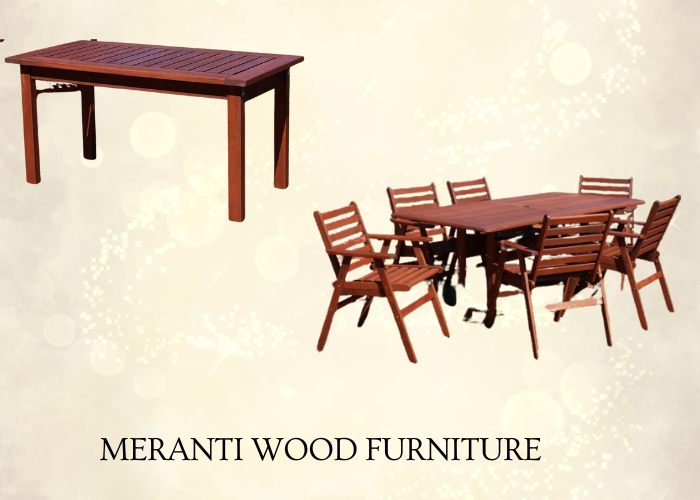Meranti wood is a robust, multi-purpose tropical hardwood type that is commonly used to make furniture and building materials. This wood is found primarily in Southeast Asia, in the Shorea genus, and is prized for its beauty, strength, and lightness. The name “Philippine Mahogany” is often incorrect, as it does not actually belong to the mahogany group.
Meranti wood significantly differs in color, usually, it will range from the lightest brown to the darkest red-brown and it has a fine, straight grain that will sometimes have irregular patterns, thus, making the uniqueness of each piece come out. Massively sought after meranti wood is a significant export in many Southeast Asian countries, and it is carefully harvested due to its wide use in the industrial and artistic sectors.
Types of Meranti Wood
Dark Red Meranti
Known for its rich, dark reddish-brown color.
Often used in applications requiring durability, such as decking and furniture.
Includes various subtypes like Bukit, DUC, Nemesu, Seraya, and Seraya Majau, each differing in properties like density and durability.
Light Red Meranti
Characterized by a lighter, pale red to straw color.
Commonly used for interior applications such as cabinetry and moldings due to its aesthetic appeal and ease of workability.
White Meranti
Typically lighter in color, ranging from white to pale yellow.
Less durable compared to the red varieties and often used in non-structural applications.
Yellow Meranti
Features a yellowish-brown heartwood.
Similar in properties to Light Red Meranti but with distinct coloration.
Balau
Sometimes included in discussions about Meranti; it is a separate group within the Shorea species but shares similar characteristics and uses.
The History of Meranti Wood
Origins and Species
Geographical Distribution: Meranti is derived from various species of the Shorea genus, which belongs to the Dipterocarpaceae family. Almost 196 species of Shorea are distributed in tropical forests of Southeast Asia representing a considerable proportion of this family. Species commonly associated with Meranti include Shorea pauciflora, S. acuminata, S. platycarpa, and S. platyclados.
Common Names: It is sometimes called, Philippine mahogany or Lauan, and actually there are different types of Meranti that are classified by heartwood color, including Dark Red Meranti, Light Red Meranti, White Meranti, and Yellow Meranti. “Philippine mahogany” is a trade name, a term that describes how the wood looks rather than where it comes from botanically.
Historical Context
Commercial Exploitation: Although the potential of Meranti wood was realized in the 1930s, when Japanese companies began logging it out of the Philippines on a large scale. Advancements in rotary cutting technology facilitated a more economical conversion of this wood species into plywood products.
Global Trade: As demand for tropical hardwoods grew, Meranti quickly became one of the most traded hardwoods globally. Its applications expanded beyond furniture to include construction materials, marine applications, and decorative veneers. The wood’s affordability compared to more traditional hardwoods like mahogany made it an attractive option for various industries.
How Meranti Wood Compares to Other Woods
| Characteristic | Meranti | Teak | Mahogany |
| Color | Light to dark reddish-brown | Golden to dark brown | Reddish-brown to deep red |
| Grain | Straight to interlocked | Straight | Straight to interlocked |
| Texture | Coarse | Fine to medium | Fine |
| Density (kg/m³) | 675 | 600-700 | 800-900 |
| Janka Hardness (N) | 3,570 | 3,500-4,000 | 4,000-5,000 |
| Durability | Moderately durable | Highly durable | Very durable |
| Resistance to Moisture | Poor | Excellent | Moderate |
| Applications | Furniture, cabinetry, marine plywood | Outdoor furniture, decking | Furniture, cabinetry, musical instruments |
| Workability | Easy (may dull tools) | Easy | Moderate |
| Cost | Generally lower | Higher | Higher |
Also read: Understanding Ebony Wood: A Detailed Breakdown
Cedar Wood: Features and Benefits Revealed
Applications of Meranti Wood
Furniture Manufacturing

Meranti is commonly used for making furniture, such as tables, chairs, and cabinets. Its red-brown color and linear grain are particularly sought after for high-quality furniture pieces.
Doors and Windows
The wood’s stability and resistance to warping make it ideal for doors and window frames. Meranti adds aesthetic appeal while providing structural integrity.
Flooring
Due to its density and durability, Dark Red Meranti is also suitable for hardwood flooring, as it can hold up and withstanding the high traffic environment.
Plywood and Veneering
Meranti is commonly used in the production of plywood panels and veneers, which are utilized in cabinetry, wall paneling, and hollow-core doors. Its smooth surface enhances the appearance of finished products.
Joinery and Mouldings
This is an easily crafted and visually appealing wood, making it well suited for interior joinery applications including architraves, skirting boards and decorative mouldings.
Marine Applications
Meranti’s natural resistance to decay makes it a popular choice for boat building and other marine woodwork applications.
Construction
It is used in light structural framing for non-load-bearing applications like room dividers and partitions, as well as in general construction projects.
Musical Instruments
Sometimes, Meranti is used to make musical instruments like acoustic guitars as it has tonal attributes.
Outdoor Applications
While generally recommended for indoor use, Dark Red Meranti can be utilized for some outdoor projects where moderate durability is sufficient, such as decking or siding when properly treated.
Disadvantages of Meranti Wood
Low Weather Resistance: Compared to other hardwoods, meranti has low weather resistance; this factor limits its use in outdoor applications, unless treated properly.
Regular Maintenance Required: For meranti to retain its looks and longevity, it requires regular maintenance, including finishing and varnishing.
Susceptibility to Insects: It has minimal natural resistance against insects that can, over time, compromise its integrity unless it is treated with preservatives.
Less Strength Compared to Other Hardwoods: Meranti is softer and less dense than other hardwoods such as oak or mahogany, and therefore not suited to heavy-duty construction or high-stress uses.
Potential for Splintering: The wood can be prone to tear-out and splintering during machining if not handled carefully.
Dulling Effect on Tools: Due to silica presence, Meranti tends to dull cutting tools more rapidly than some other types of wood, necessitating sharper cutting implements to work effectively.
FAQs
What is meranti wood used for?
Meranti wood is commonly used in furniture, cabinetry, flooring, and construction projects. It is also used in specialty applications like boat building and joinery.
How do I care for meranti wood furniture?
Regular cleaning, avoiding direct sunlight, and applying a protective finish will help preserve the beauty and longevity of meranti wood furniture.
Is meranti wood strong?
While not as dense as some hardwoods, meranti is considered a strong and durable wood suitable for a variety of applications, especially in furniture and cabinetry.
Can meranti wood be stained?
Yes, meranti wood stains well and can take on a variety of colors, from light to dark shades, depending on the finish applied.

